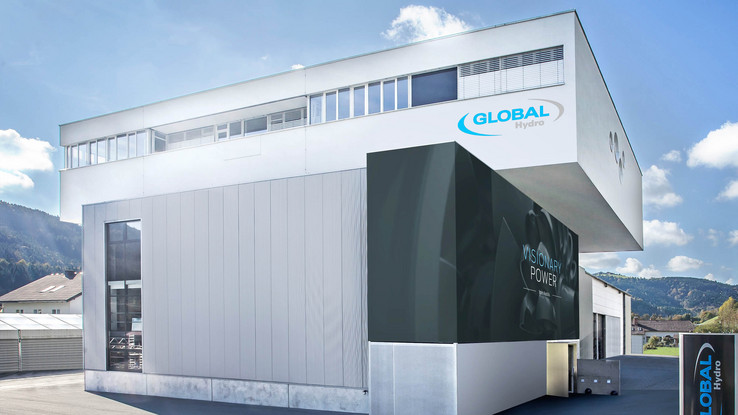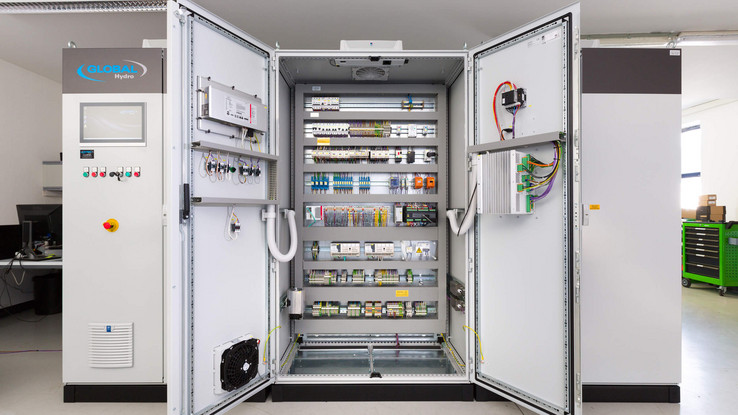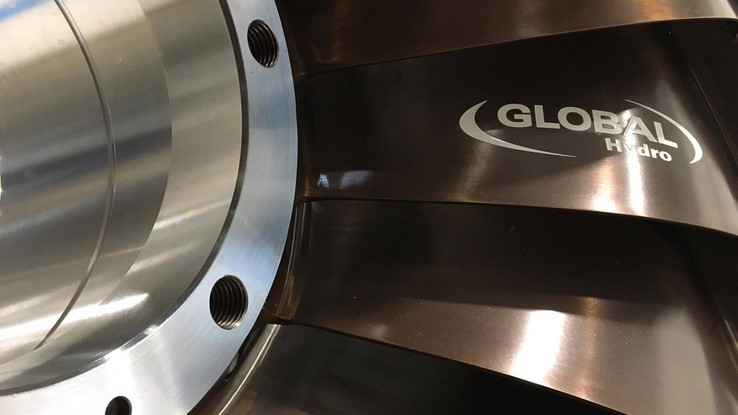From software to solution
One decision optimizes the entire process
Hydropower plants are a sustainable and reliable source of electric power. GLOBAL Hydro is a leading global provider of hydropower technology. The company from Upper Austria is successful on the world market not only for its high-quality mechanical engineering, but also for its highly innovative control technology, coupled with comprehensive software solutions that drive the efficiency of power plants to new heights. Recently, GLOBAL Hydro has started utilizing the EPLAN platform for its engineering, a decision that optimizes the entire process. Moving to the cloud is the next step.
Energy from hydropower is a safe, predictable source of energy based on proven, advanced technology. GLOBAL Hydro, with its headquarters in Niederranna and right on the banks of the Danube River in Austria, supplies electromechanical equipment for hydropower plants. At its core, the company specializes in the supply of all electromechanical power plant equipment – including research, development and design. A workforce of 180 employees design and produce all efficiency and efficiency-relevant core components in Austria's Mühlviertel region using state-of-the-art production facilities. Another core competence is the electrical engineering necessary for the turbine. Thomas Stütz, Director of Electrical Engineering at GLOBAL Hydro: "We offer a complete package from a single source, from a 24 V power supply to the 110 kV transformer station." The Austrian team finds their markets worldwide: The company has subsidiaries around the world to accommodate its focus on Europe, South East Asia and South America. GLOBAL Hydro can assume responsibility for the entire project management if the customer so requires: This level of service underscores the company's expertise.
Increasing efficiency
A key factor when operating a hydropower plant is its efficiency. On its face, turbine construction is a very traditional technology that may appear to be exhausted at first glance. However, Thomas Stütz is adamant that this is not the case: "Essentially, it is not so much the principle of operation that has evolved, but instead the way a turbine is manufactured. The greatest challenge, though, is how to optimize, thereby increasing efficiency." To take this to the extreme, GLOBAL Hydro is pushing digital models, so-called "CFD" simulations. With these "Computer Fluid Dynamics" analyses, the flow conditions within the turbine become visible. The results allow the mechanical parameters to then be refined, ensuring that the hydropower plant can ultimately be operated with the greatest possible efficiency. However, this does not stop at the turbine: "The computer model calculates the power plant in its entirety. Not only are the conditions inside the turbine taken into account, but also, for example, the flow patterns in the inlet area, enabling them to be optimally designed or adapted," explains Stütz.
Control system boosts efficiency
What should also be underlined is the sophisticated control technology. Intelligent algorithms always ensure efficient operation in line with the current flow rate. "This innovative technology optimizes operation at all times, ensuring the system’s maximum overall efficiency, setting ourselves apart from our market competitors," says Stütz. True potential for innovation in traditional turbine technology is found in software and control technology. Constant analysis, sophisticated sensors, cloud-based solutions: GLOBAL Hydro offers power plant operators perfectly coordinated tools. This applies not only to the design of new power plants, but to revitalization as well: Without having to replace the entire mechanical part, efficiency can be significantly increased by modernizing and optimizing the control technology. This applies to both new construction and revitalization alike: For customers, safe operation is key. This includes constantly monitoring the function of the turbine and its auxiliary units to detect and rectify any faults as early as possible. After all, a low internal energy requirement increases the efficiency of the power plant overall. Examples include monitoring leakage in hydraulic lines or using sensors for detecting vibrations. "Because a turbine runs around the clock and is difficult to access at the same time, condition monitoring and remote service are particularly important," says Stütz.
Linking predefined functions
GLOBAL Hydro relies on EPLAN solutions in its control system design. "A bit over a year ago, we came up with the idea of putting the engineering process on a new footing," explains Thomas Stütz. "We felt it was important to not simply replace one software with another, but to optimize the entire process." The EPLAN platform was able to fully meet this requirement – with improved performance, greater consistency and, last but not least, a more pleasant look and feel. Using the central EPLAN Electric P8 element, engineers at the Austrian company now handle the entire circuit planning process – consistently, seamlessly, and quickly. This includes all the benefits of the much-cited "batch size 1" – standard at GLOBAL Hydro, where each turbine is individually manufactured, but each function is repeated. This makes it ideal for use with the EPLAN platform: The hydropower specialists have predefined and stored the each of the sub-functions, ranging in the hundreds, including variants, in the software. Work performed with Electric P8 is supported by "advance data collection" via EPLAN Preplanning: In this specific case, any functions offered or sold can be imported directly into the EPLAN platform using a sales configurator. This makes drawing the circuit diagram quick and easy: EPLAN Electric P8 generates the basic functions of the control system almost automatically, while the others can be easily added. This makes the work extremely efficient, underscores Stütz: "In the planning process, assembling individual components became the linking of predefined functions" Plus, continuous standardization is achieved in planning, production, delivery and documentation. Because: Once recorded in the schematic, project data forms the basis for automated completion of the machine and system documentation. What was once a tedious and time-consuming search for data sheets is now a thing of the past.
Interface to production
"What we found particularly exciting about the EPLAN platform was that we can also integrate the actual production process into the planning, because it is very easy to supply engineering data to milling machines or wire processing machines, for example. EPLAN gave us the certainty that the solution was not fully developed the minute the circuit diagram was finished," says Thomas Stütz. More specifically, GLOBAL Hydro utilizes the EPLAN ProPanel design and 3D visualization program as an interface between circuit planning and production. The "digital twin" evaluates data and then shares it with production. These are two examples: Drilling patterns are much easier to export and the fill level of cable ducts is much easier to read. A major relief in the day-to-day work. GLOBAL Hydro also uses manufacturer plug-ins integrated by EPLAN – including for terminal strips. As such, ordering from external suppliers is very convenient. Stütz continues: "So, we were provided a real solution to match our requirements, not simply software."
Keeping data under control
In addition to the software solutions, Thomas Stütz is extremely satisfied with the service from EPLAN and the support provided during the transition. An introduction concept designed by EPLAN based on GLOBAL Hydro's requirements perfectly supported its staff during the initial phase. The next step with EPLAN is already being conceived: EPLAN eVIEW Free. This cloud-based solution makes EPLAN projects available to all project participants along the entire value chain – from engineering, production and assembly through to service and maintenance. The location-independent, comprehensive, and secure collaboration on a project is something that a company like GLOBAL Hydro that does business on an international stage can really appreciate. For example, if an employee submits change requests on site, they are transferred to all documents via the cloud and are then available for further editing. Obviously, the complete history is stored, thus ensuring transparency. Stütz continues: "For us, this is a very interesting solution because, with it, we will no longer have employees working on different versions of a circuit diagram. This enables us to effectively avoid errors and ambiguities."
By Martin Gold, journalist, author and photographer, Vienna






